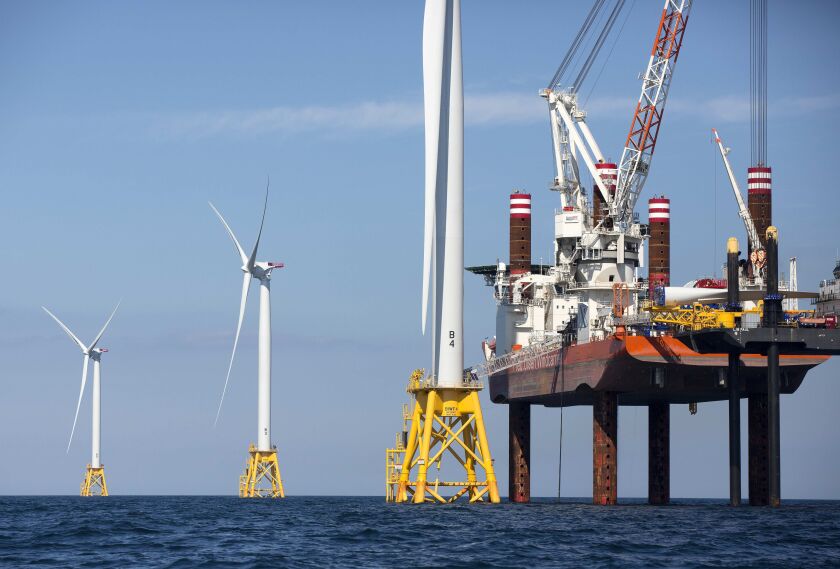BOSTON — The construction of dozens of wind turbines off the coast of Nantucket, Mass., threatens the survival of a dwindling number of endangered North Atlantic right whales, a group of residents of the affluent resort island say in a newly filed federal lawsuit.
ACK Residents Against Turbines said Vineyard Wind’s proposed project of 60 turbines 14 miles south of the island would be in a crucial area for foraging and nursing for the species, which researchers estimate number fewer than 400.
Mary Chalke, a Nantucket resident and member of the opposition group, said the lawsuit, filed in federal court in Boston, isn’t just about Vineyard Wind but also other turbine projects that are in the pipeline along the Eastern Seaboard.
“We all want renewable energy,” Chalke said after the group filed the suit. “This represents the transformation and industrialization of a pristine natural environment.”
The U.S. Bureau of Ocean Energy Management and the National Oceanic and Atmospheric Administration, which are named in the suit, declined to comment.
Vineyard Wind — a joint project of a Danish company and a U.S. subsidiary of the Spanish energy giant Iberdrola — also would not comment.
The American Clean Power Association, a group that represents renewable energy companies, said the project has undergone a lengthy environmental review, permitting and public comment process.
“It appears this lawsuit is being brought by residents motivated by aesthetic concerns as much as anything alleged in their complaint,” said Tom Vinson, a vice president of the industry group.
Vallorie Oliver, a Nantucket resident, acknowledged that visibility of the towering structures — which could be as tall as 850 feet, eclipsing Boston’s 790-foot Hancock Tower — is among the group’s concerns.
But Oliver said federal officials also haven’t provided adequate research to support their claims that the wind project would have minimal impact on right whales and other marine life.
“We’re simply asking for real science-based answers to the impact on our natural environment,” she said.
Approved in May, the nearly $3 billion, 800-megawatt project would be the first utility-scale wind power development in federal waters. It’s slated to become operational in 2023, generating enough electricity to power 400,000 homes.
The project and Ocean Wind, a proposed 1,100-megawatt offshore wind project off New Jersey, are keystones in the Biden administration’s push to develop offshore wind as a way to fight climate change and create jobs.
The projects could be joined by as many as five other large-scale projects totaling more than 2,000 turbines across 2,000 square miles of ocean, according to ACK Residents Against Turbines.
U.S. offshore wind development is still far behind Europe. A small wind farm operates near Block Island in waters controlled by the state of Rhode Island, and another operates off the coast of Virginia.
The Nantucket group — whose name refers to the ACK three-letter code for the island’s airport — is the latest effort opposed to large-scale wind projects.
Fishermen who ply the lucrative waters from New Bedford, Mass., to Montauk, N.Y., have long worried about the potential impacts to their livelihood.
Bob Vanasse, who heads the fishing advocacy group Saving Seafood, said Vineyard Wind and other projects proposed in the region could hurt fisheries including squid, clams and scallops.
“There are a number of groups in various fisheries who have raised concerns about the insufficiency of the planning and review effort,” Vanasse said.
Vineyard Wind also comes years after the infamous Cape Wind project, which failed after litigation from another group that included Nantucket property owners.
Supporters of Vineyard Wind have said the newer project is better sited than Cape Wind, which was proposed closer to shore.
Recent wind projects proposed off North Carolina and New York, though, have been pushed farther offshore over environmental concerns, said David Stevenson of the Caesar Rodney Institute, a Delaware group that opposes wind farm proposals.
He argued that Vineyard Wind’s project should be placed as far as 30 miles from shore.
“Fifteen miles was not OK in North Carolina or Long Island, then why is it OK for Nantucket?” Stevenson said.






